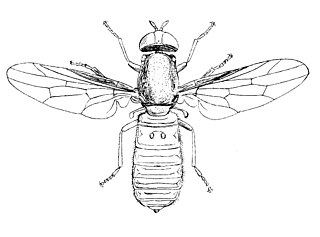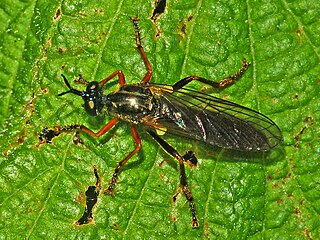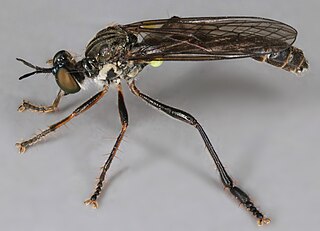
The Conopidae, also known as the thick-headed flies, are a family of flies within the Brachycera suborder of Diptera, and the sole member of the superfamily Conopoidea. Flies of the family Conopidae are distributed worldwide in all the biogeographic realms except for the poles and many of the Pacific islands. About 800 species in 47 genera are described worldwide, about 70 of which are found in North America. The majority of conopids are black and yellow, or black and white, and often strikingly resemble wasps, bees, or flies of the family Syrphidae, themselves notable bee mimics. A conopid is most frequently found at flowers, feeding on nectar with its proboscis, which is often long.

The Asilidae are the robber fly family, also called assassin flies. They are powerfully built, bristly flies with a short, stout proboscis enclosing the sharp, sucking hypopharynx. The name "robber flies" reflects their expert predatory habits; they feed mainly or exclusively on other insects and, as a rule, they wait in ambush and catch their prey in flight.

The Therevidae are a family of flies of the superfamily Asiloidea commonly known as stiletto flies. The family contains about 1,600 described species worldwide, most diverse in arid and semiarid regions with sandy soils. The larvae are predators of insect larvae in soil.

The Agromyzidae are a family of flies, commonly referred to as the leaf-miner flies for the feeding habits of their larvae, most of which are leaf miners on various plants. It includes roughly 2,500 species, they are small, some with wing length of 1 mm. The maximum size is 6.5 mm. Most species are in the range of 2 to 3 mm.

Empididae is a family of flies with over 3,000 described species occurring worldwide in all the biogeographic realms but the majority are found in the Holarctic. They are mainly predatory flies like most of their relatives in the Empidoidea, and exhibit a wide range of forms but are generally small to medium-sized, non-metallic and rather bristly.

The Scenopinidae or window flies are a small family of flies (Diptera), distributed worldwide. In buildings, they are often taken at windows, hence the common name window flies.

Tachina fera is a species of fly in the genus Tachina of the family Tachinidae. It was first described by Carl Linnaeus in 1761.

Empis tessellata is a species of dance fly, in the fly family Empididae. It is included in the subgenus Euempis.

Empis ciliata, the black dance fly, is a species of dance fly, in the fly family Empididae. It is included in the subgenus Euempis.

Atherix ibis, the yellow-legged water-snipefly, is a species of ibis flies belonging to the family Athericidae, a small family very similar to Rhagionidae.

Chloromyia formosa is a species of soldier flies belonging to the family Stratiomyidae. Another name for it is Broad centurion.

Beris clavipes, the scarce orange legionnaire, is a European species of soldier fly.
Dipteran morphology differs in some significant ways from the broader morphology of insects. The Diptera is a very large and diverse order of mostly small to medium-sized insects. They have prominent compound eyes on a mobile head, and one pair of functional, membraneous wings, which are attached to a complex mesothorax. The second pair of wings, on the metathorax, are reduced to halteres. The order's fundamental peculiarity is its remarkable specialization in terms of wing shape and the morpho-anatomical adaptation of the thorax – features which lend particular agility to its flying forms. The filiform, stylate or aristate antennae correlate with the Nematocera, Brachycera and Cyclorrhapha taxa respectively. It displays substantial morphological uniformity in lower taxa, especially at the level of genus or species. The configuration of integumental bristles is of fundamental importance in their taxonomy, as is wing venation. It displays a complete metamorphosis, or holometabolous development. The larvae are legless, and have head capsules with mandibulate mouthparts in the Nematocera. The larvae of "higher flies" (Brachycera) are however headless and wormlike, and display only three instars. Pupae are obtect in the Nematocera, or coarcate in Brachycera.

Diogmites is a genus of mainly neotropical flies in the family Asilidae or robber flies.

Coenosia agromyzina is a species of fly in the family Muscidae.

Neoitamus melanopogon, commonly known by the name common robber fly, is a species of fly of Asilidae in the genus Neoitamus, found in both the principal islands of New Zealand.

Dioctria rufipes, the common red-legged robberfly, is a species of robber fly in the subfamily Dasypogoninae of the family Asilidae.

Neoitamus cothurnatus, the scarce awl robberfly, is a species of 'robber fly' belonging to the family Asilidae.

Hyperechia is a genus of robber flies in the family Asilidae. They appear large, stout and with legs covered in bristles and appear like carpenter bees in the genus Xylocopa and the resemblance is considered as a case of aggressive mimicry, providing protection from predators. The larvae of the fly feed on the larvae of Xylocopa within their cavity nests in wood. They are mainly found in the African and Madagascan region with about 15 species and two species in Asia.

Dioctria hyalipennis is a Holarctic species of robber fly in the family Asilidae.























